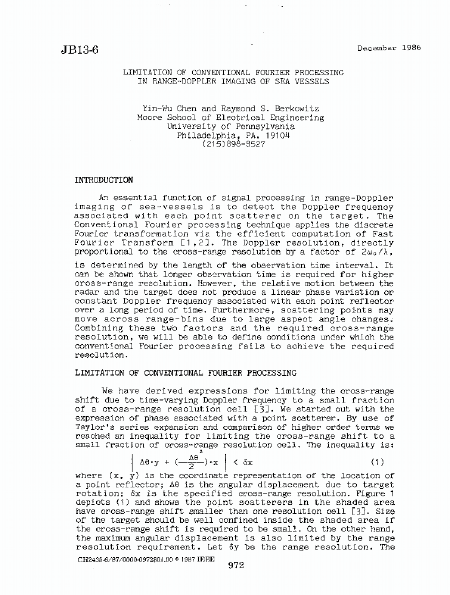|
| Read the Raymond Stanley
Berkowitz CV
PDF File 20 meg. 35 Pages
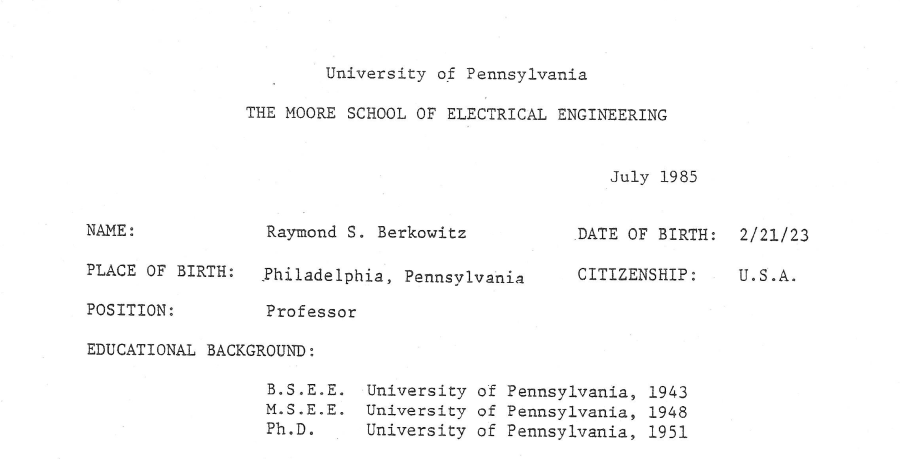
|
|
|
IEEE
2004 IEEE Radar Conference
Philadelphia Radar Pioneer Recognition
Award
The 2004 IEEE Radar Conference
Recognizes
Dr. Raymond S. Berkowitz
for his participation in the Special Summer Session of Moore
School
of Electrical Engineering held at the University of
Pennsylvania
during the summers of 1960 and 1961 which resulted in publication
of
the book: "Moden Radar: Analysis, Evaluation, and System
Design"
and for his significant contributions made to Radar Science during
the
past half century.
|
|
Philadelphia
Radar
Pioneer
Recognition
Award
Introduction Speech
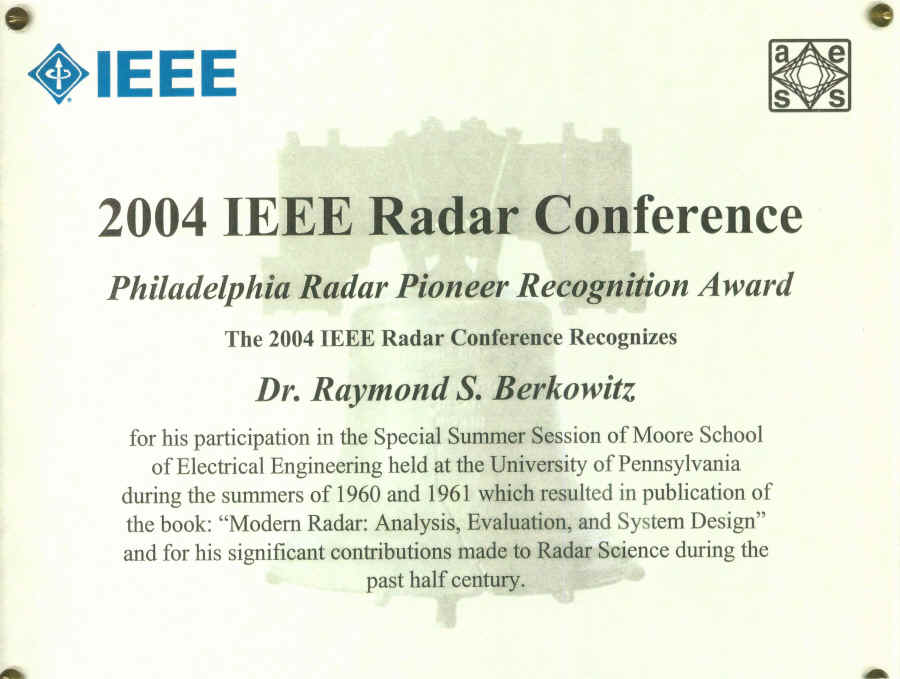
|
IEEE
2004 IEEE Radar
Conference
Philadelphia Radar Pioneer Recognition
Award
The 2004 IEEE Radar Conference
Recognizes
Dr. Raymond S. Berkowitz
for his participation in the Special Summer Session of Moore
School
of Electrical Engineering held at the University of
Pennsylvania
during the summers of 1960 and 1961 which resulted in
publication of
the book: "Moden Radar: Analysis, Evaluation, and
System Design"
and for his significant contributions made to Radar Science
during the
past half century.
|
|
|
Philadelphia
Radar
Pioneer
Recognition
Award
(Following
are the remarks delivered by Barry Fell, BAE
SYSTEMS, Advanced
Systems and Technology,
Lansdale
PA, at the 2004 IEEE Radar Conference, held at the 'Wyndham
Franklin Plaza Hotel,
in
Philadelphia PA on Tuesday evening,
27
April 2004)
It's
a pleasure to address you this evening about the presentation of an
award that is
unique to the 2004 IEEE
Radar Conference.
This
is the first year this prestigious
conference is being held in
Philadelphia.
We
are honored to be able to host this
conference and hope that all of you are finding this conference is
meeting your
expectations.
Before
I
make
the presentation
of this special
award,
I
would
like to be certain
that
someone very special gets the recognition he deserves.
The
idea for holding the 2004
IEEE Radar Conference in Philadelphia occurred when John Smith,
Joe
Teti,
and
I
attended
the 2002 IEEE Radar Conference in Long Beach California.
When
we returned
to Philadelphia,
I
got a call from
John.
He
was very
excited about the possibility
of
holding the IEEE Radar Conference in Philadelphia in
2004.
And
here we are.
This
conference was made possible by the hard work of a number of people
that have been
recognized earlier.
But
for any group to be effective it requires a good leader.
I
would
like to formally
recognize John
Smith, for the leadership
and guidance he has given the
organizing committee and all
those individuals
who have contributed
to
making this
conference a success.
The
face of the Radar Industry
has changed drastically over
the
last 60 years.
I
can
only
speak first hand about the US
Radar
Industry
but I am certain the same is true
for
the
United Kingdom,
France,
Germany,
Italy,
Poland,
the
Soviet
Union,
China,
and
Japan.
In
the US,
such
companies as Hughes, Bendix Radio, and Texas Instruments
are now part
of
the Raytheon
Corporation.
Norden
and Westinghouse
are now part
of the Northrop-
Grumman
Corporation.
RCA
and GE have now become
The Lockheed Martin
Company.
Some
operations like the Sperry Radar Division (Sperry Gyroscope)
in Great
Neck
Long Island no longer exist.
Let
us transport ourselves
back
in time to the early 1960s.
A
few
years
earlier,
the
Soviet
Union
had launched the first artificial
satellite that orbited the earth --
Sputnik.
This
was
made possible
by a very powerful rocket
booster that could also
deliver
nuclear
warheads
across
the North Pole to the United States. The United States response to
this potential
problem
was to develop the Ballistic Missile
Early
Warning
System (BMEWS)
with
radar sites in Alaska,
Greenland,
and the United
Kingdom.
The
contractor
responsible
for
this
project
was RCA Missile
and Surface Radar in
Moorestown NJ located about 20
miles from this hotel.
The
BMEWS
system
consisted of two types
of radar.
The
ANIFPS-SO surveillance
radar,
which was the size of a football field (50 m x 120
m),
was
built by the General Electric Heavy Military Division in Syracuse
NY. The Tracking
Radar,
the
ANIFPS-49,
with
its 84 foot dish antenna, was
built by
RCA
Missile
and
Surface
Radar.
For
many
years
the FPS-49
test
site sat
next
to Exit 4
of
the New
Jersey
Turnpike
until
it was replaced in the 1970s by the current AEGIS
System
Land
Based
Page -1-
|
Test
Site (LBTS).
The
LBTS
is
commissioned as
a ship
in the US
Navy.
It
is known as
the
"cruiser
in the cornfield"
or
by its official
name the SS
Rancocas.
Philadelphia
was
an opportune
place
for the advancement
of
Radar
Science
during
the
1960s due
to
RCA,
the
RMEWS
program
and another
name
of
a bygone
era,
the
Philadelphia
Corporation (Phi1co).
In
1960,
three
radar
scientists,
Dave
Barton,
Walter
Weinstock
and Raymond
Berkowitz got together
in
Walt
Weinstock's
basement in
Northeast
Philadelphia
to
develop a summer lecture series that would cover
all
aspects
of
Modem
Radar
Systems
Technology.
They
decided to gather
together
some
of the most
well
known contributors
to Radar Science
and present
a summer course
in
Radar
at the
University
of Pennsylvania.
The
course was
taught over
the
summers
of 1960
and
1961
at
the University
of
Pennsylvania,
Moore
School of Electrical
Engineering,
about
16
blocks
west
of this hotel.
In
1964
the John
Wiley
Publishing
Company
approached
Raymond
Berkowitz,
professor
of Electrical
Engineering
at the University of Pennsylvania,
with
the request
that
the
summer lectures
be made into a book.
This
resulted in the book "Modem
Radar:
Analysis,
Evaluation,
and
System
Design"
which
was published
in
1965.
The
significant
radar
systems
books that
had
been published
previously
were:
•
"Principles
of Radar"
published
in
1944
by
the
Radar
School
at
MIT, edited
by
Francis
Reintjes and Godfrey
Coate
·
The
28
volume
MIT
Radiation
Laboratory
Series,
published
after
world
war II,
edited
by
Louis
Ridenour
and
George
Collins
•
Merrill
Skolnik's,
"Introduction
to Radar
Systems",
published
in
1962,
and
•
David
Barton's,
"Radar
Systems
Analysis",
published
in 1964
(as
a sidenote,
Merrill
Skolnik
participated
in the first
set of radar
lectures
at the
University
of
Pennsylvania
in
1960
but left the group to complete
the
writing
and
publication of "Introduction
to Radar
Systems".
This
is why
he was
not
a
contributor
to
the
writing and publication
of "Modem
Radar")
The
book "Modem
Radar"
represented
the state of the art in
Radar
Science
in the early
1960s.
The
14 authors
represented the significant
centers
of
Radar
in the
Eastern
United
States.
The
institutions
represented were:
•
Bell
Telephone Laboratories
•
Columbia
University
•
General
Atronics
on East Mermaid
Lane in Wyndmoor
PA
(General
Atronics
was
purchased
by
Magnavox
Communications,
then
Hollandse Signaal,
and is
now
DRS
Communications)
•
General
Electric
•
Polytechnic
Institute
of Brooklyn
•
Raytheon
•
RCA
Laboratories
in Princeton NJ
(now
the
Sarnoff
Research
Center
of
SRI
International)
Page -2-
|
|
•
RCA
Missile
and Surface Radar
in Moorestown
NJ (now
Lockheed
Martin)
•
Sperry
Gyroscope
Company
•
University
of Michigan
•
University
of Pennsylvania,
and
•
Wheeler
Laboratories
The
contributors included many names that are readily
recognizable as fundamental
contributors
to
radar
science:
|
•
|
William
Bennett
|
|
•
|
Seymour
Charton
|
|
•
|
Charles
Cook
|
|
•
|
Louis
Lambert
|
|
•
|
George
Millman
|
|
•
|
L.
S.
Nergaard
|
|
•
|
Marlin
P.
Ristenbatt
|
|
•
|
Mischa
Schwartz
|
|
•
|
Norman
Spencer
|
plus
the
5
individuals that
we
honor
tonight:
•
David
K.
Barton,
who
was a Radar
Systems
Engineer
at
RCA
in
Moorestown
·
Raymond
S.
Berkowitz,
who
was
professor
of
Electrical
Engineering
at
the
University
of Pennsylvania
Moore
School
•
Bernard D.
Steinberg,
who was Vice
President in charge
of Research and
Engineering at General Atronics
·
Harry
Urkowitz,
who
was a Senior
Engineering
Specialist
at General
Atronics,
and
•
Walter W.
Weinstock, who
was a Radar Systems Engineer at RCA
in
Moorestown.
The
subject matter covered by
the
book included:
•
Linear
Systems
Theory
•
Radar
Range
Equation
•
Signal
Analysis
·
Probability
Distribution Functions
·
Statistical
Decision Theory
•
Theory
of
Detection of Signals in Noise
•
Target
Parameter
Estimation
•
Radar
System
Sensitivity
Analysis
•
Ambiguity
and Resolution
•
Pulse
Compression
•
Propagation
of Radio
Waves
•
Target
Clutter and Noise Spectra
Page
-3-
|
•
MTI
and
Feedback
adaptive
filters
•
Pre-detection
Integration
•
Radar
Cross
Section
Target Models
•
Tracking
Radar Analysis, and
•
Satellite
Tracking Radar Design
Technologies
covered, which
represented
the state-of-the
art at the
time,
included:
•
Antenna
Theory
•
Modern
Low-Noise
Devices,
and
•
Optical
Correlation
for linear
FM
pulse
compression.
"Modern
Radar" complemented the books by Skolnik and Barton by covering
some
specialized
topics
in Radar
Systems Engineering more deeply and by presenting alternate
and
unique
approaches
to the basic analysis of Radar
System
Performance.
Today, 59
years
after
its first
publication,
"Modern
Radar"
is still a valuable book for any Radar
Library
Reference
Shelf.
Tonight
we
would
like
to recognize these five Philadelphia
Pioneers
of Radar
Science.
Let
me tell
you
a
little
about each one.
David
K.
Barton
became a fellow of the
IEEE
in
1971
for his
"contributions
to
precision
tracking
radar and
radar
systems engineering".
David
received
his
AB degree in Physics
from Harvard College
in 1949.
He
worked for
the
Army
Signal
Corps at White
Sands
Missile
Range and the
Evans Signal
Laboratory,
which
is now known as Fort
Monmouth
in
Belmar NJ (this is
the site where Edward
H Armstrong
used his experimental
regenerative
receiver to receive transatlantic
radio
signal transmissions for the Marconi
Company
and
in
1946 the US Army
Signal Corps received the first radar returns from the
moon). David worked at
RCA
in Moorestown
New
Jersey from
1955
to 1963 where he
developed
the
ANIUPS-1
Surveillance Radar,
the
ANIFPS-16
precision tracking
radar
(which is
still
the primary precision
tracking radar in use throughout
the world),
and the
ANIFPS-49
BMEWS tracking
radar.
In
1958
he
was the first
recipient of the RCA
David
Sarnoff Award for "outstanding
achievement
in Engineering".
In 1963 he joined the
Raytheon Company in Wayland Massachusetts
as a Staff Engineer.
At
Raytheon
David
Barton
was
system
engineer
for the Missile
Site
Radar
(MSR)
of the Safeguard
system,
and
the
AN/TPN-19
ground-controlled
approach
radar
system.
He has authored many
papers,
made major
contributions
to books
on radar, and published a number of books on
radar science
that
include:
•
Radar
Systems
Analysis
•
Handbook
of Radar Measurement
(with
Harold
Ward)
•
The
7 Volume
ARTECH
House
Series
on Radars
•
Modern
Radar
Systems
Analysis
(a revision of his original book)
Page
~4-
|
|
In
1984 he co-founded
ANRO Engineering
where
he is currently
Executive
Vice
President
and Consultant.
In
1997
he was elected to the National
Academy
of
Engineering. He is currently
series editor
for the
ARTECH House Radar Series.
His
contributions
to
the book
"Modem
Radar" include
being
one
of the
organizers of the
summer school lectures
and writing the 3 chapters covering: "The Radar Equation",
"Tracking
Radars",
and
"Satellite
Tracking."
Raymond
S.
Berkowitz
became a fellow of the IEEE in 1981 for his
"contributions
to
advanced data processing techniques in modern radar and engineering
education."
Ray
received his undergraduate
degrees from the University of Pennsylvania and his
PhD
from the University of Pennsylvania in 1951.
He
worked at RCA in Moorestown New
Jersey as an engineer and later as a consultant.
Most
of his career was spent as a
professor
at the University of Pennsylvania,
Moore
School
of Electrical Engineering.
He
is author of numerous papers on basic radar science and was Editor
of the book:
••
Modem
Radar: Analysis,
Evaluation, and System Design
He
is probably best known for his work in parameter estimation,
radar
systems
engineering,
and radar systems performance evaluation.
Ray
is professor emeritus
at the
University of Pennsylvania,
Moore
School and is now in retirement.
His
contributions to
the book "Modern
Radar"
include
organizing the summer school1ectures,
being
the
book's
Editor, and writing the four chapters: "Basic
Radar Concepts",
"Linear
System
Analysis
Fundamentals",
"Complex
Signal
Analysis Concepts",
and
"Target
Parameter
Estimation."
Bernard
D. Steinberg became a fellow of the IEEE
in 1966 for "contributions
toward
advancing the theory of radar,
sonar,
and
communication systems, and for reducing
advanced theories to practical forms of engineering applications."
He received his BS
and MS from MIT.
He
received his PhD from the University of Pennsylvania in 1971.
He
is cofounder of General Atronics where he was Vice President of
Research and
Engineering. He was also
a cofounder and Chairman of the Board of Interspec
Incorporated.
Upon
receiving his PhD in 1971, Bernard accepted
a position
as professor
at the University
of
Pennsylvania,
Moore
School.
He
has written numerous papers on
basic radar science and has published three books:
•
Principles
of Aperture and Array System
Design
•
Microwave
Imaging with
Large Antenna Arrays
•
Microwave
Imaging Techniques
He
is best known for his fundamental work in advanced signal processing,
adaptive
beamforming
arrays,
Synthetic
Aperture Radar (SAR),
and
development of the
Radio
Camera Technology.
He
is professor emeritus at the University
of Pennsylvania,
Moore
School and is
enjoying his retirement.
His
contributions
to the book "Modem
Radar"
include writing the 4 chapters: "Target Clutter and
Noise
Spectra",
"MTI
Radar Filters",
"Radar
Feedback Filters",
and "Predetection Integration."
Page -5-
|
Harry
Urkowitz became a
fellow
of the JEEE
in 1973
for "contributions
to radar
signal
processing and to graduate education".
Harry received his BS
from
Drexel
University in
1948
and his MS
and
PhD
from
the University
of Pennsylvania
in
1954
and 1972
respectively.
Harry began his
career
at
the Philco
Corporation where
he worked from
1948
to 1964. In
1964
he
joined Bernard Steinberg
at General
Atronics
as a Senior
Engineering
Specialist.
In
1970
he joined the staff at
RCA
Missile
and
Surface
Radar
in
Moorestown
New
Jersey
as
a
Principal
Member
of the Engineering
Staff.
Harry
has
written numerous papers
on radar signal processing.
He
developed
the "Urkowitz
filter"
which
is the realizable
matched filter
that
describes
detection of a known signal in
stationary
radar clutter.
Harry
has been teaching Random
Processes
and
Signal
Processing
courses as an
adjunct
professor
in
the Drexel
University
Graduate
School
since
1952.
His
book "Signal
Theory
and Random Processes"
was developed based on
his
course notes.
He
will
be presenting the tutorial
on Detection
Theory
with
Dr
Thomas
F.
Halpin
tomorrow night at this
conference. Harry
maintains
his full
time
status
at
Lockheed
Martin
in Moorestown
New
Jersey
where
he
has
worked
continuously
since
he
joined RCA in 1970. He
was
awarded the
Drexel
University
Distinguished
Alumni
Award
in
1989.
I
would
also
like to note that Harry
did
not
get
his introduction
to
radar
by
reading the textbooks we
have
mentioned earlier
tonight.
His
introduction to radar
was
as an
Airborne
Radar
Observer
during
the 2nd
World
War, where
he rose
to
the rank
of
1
st
lieutenant
in the
US Army
Air
Force.
He
served
in
the
Army
Air
Force
from
1942
to
1945 during
which
he flew
more
than
30 missions
as a
Radar
observer.
For
his
service
to
this nation,
he
was awarded
the Distinguished
Flying
Cross
and
the
Air
Medal
with
3
Oak
Leaf
Clusters.
His
contribution
to
the book Modem
Radar
includes
writing
the
chapter
"Ambiguity
and
Resolution".
Walt
Weinstock
became
a fellow
of the
JEEE in
1978
for
"contributions
to
radar
systems
and
for
leadership
in the development of Modem
Air
Defense
Systems.
Walt
received
his BSEE,
MSEE,
and
PhD
from
the
University
of Pennsylvania
in
1946,
1954
and 1964
respectively.
His
first employer
was the Philco
Corporation
where
he worked
on
Airborne
Radar
from 1946
to 1949.
He
joined the
staff
of
RCA
in
Moorestown
NJ in
1949
where he remains
as a consultant today. Walt
is
the author of a number
of
papers
and is best known for the Weinstock
target model which
is
a
generalization
of the
standard
Swerling
radar target
models.
Walt
has
also made
significant
contributions to
Anti-Air
Warfare
Systems,
Ballistic
Missile
Defense,
Space
Surveillance,
Command
and
Control
Systems,
Radar
Systems
Analysis,
and
Real
Time
Computer
Control
of
Complex
Radar
Systems.
He
has
also
served
on numerous high
level
government
committees
throughout
his career which include:
the
Navy's
Advanced
Surface
Missile
System
Assessment
Group, the
Allen
Committee
on Advanced
Naval
Threat
Systems,
the
Planning
and Steering
Advisory
Group
of the
Commander
of
Naval
Operations
Surface
Ship
Security
Panel,
and
the Department of Defense
Electronic
Warfare
Technical
Study
Committee.
He
is also
a recipient
of
the ReA
David
Sarnoff
Award
for Outstanding
Achievement
in Engineering.
Walt's
contributions to the
book
Modem
Radar
include
being an organizer of the summer lectures,
and writing
3 chapters
of the book:
"Probability
Density
and
Distribution
Functions",
"Radar
Cross-Section
Target
Models",
and
"Illustrative
Problems
in
Radar
Detection
Analysis."
Page -6-
|
|
On
a personal note,
I
have had the privilege of working directly with 4 of these 5
individuals. I worked with Harry
Urkowitz and Walt Weinstock
at ReA Missile
and
Surface Radar.
When
Bernard Steinberg asked Harry
Urkowitz
and Raymond Berkowitz
who they would recommend to set up and develop a radar division at
Interspec
Incorporated,
I
received
their
endorsement
and recommendation.
Due
to this
recommendation I worked with Bernard Steinberg
for 8 years at
Interspec.
I
also
had the
chance to work with Ray Berkowitz when he was a consultant for
Interspec and attended
his lectures on detection theory at the University of Pennsylvania.
David
Barton of course had a direct influence on my career in Radar
as I
am
sure he has
touched all of you. His Radar
Systems
Analysis
Book
was one of the first books I
used
in learning radar science. More
recently, David reviewed "Radar
Fundamentals for
Optical
Engineers"
a
chapter
that
I
wrote
for
the
ARTECH
House
book "Photonic
Aspects of Modem Radar".
The
award we present this
evening to these five Philadelphia
Pioneers
of Radar Science
reads: "The
Philadelphia Radar
Pioneer Recognition Award.
The
2004 IEEE Radar
Conference Recognizes
David K.
Barton,
Dr Raymond S.
Berkowitiz,
Dr
Bernard
D.
Steinberg, Dr Harry Urkowitz,
and
Dr Walter
W.
Weinstock
for their participation in
the
Special Summer Session of the Moore
School of Electrical
Engineering held at the
University
of Pennsylvania during
the summers of 1960
and 1961 which resulted in
publication of the book:
'Modem
Radar:
Analysis,
Evaluation,
and
System
Design'
and
for their
significant
contributions
to Radar
Science
during
the
past half
century".
Please
join
me in a round
of
applause in
appreciation
of these 5
individuals
who are
truly
legends in our
time.
Thank
you.
Page
-7-
|
|
| |
|
U of Penn. Almanac
VOLUME 15, NUMBER 2 OCTOBER, 1968
DR. RAYMOND S. BERKOWITZ,
professor of electrical engineering, presented
a paper at the PPAAR Annual Symposium
entitled "Evaluation of Multipurpose
Radar Systems for Army Helicopter
Sensing Needs." He is continuing his
work as a consultant to the Missile and
Surface Radar Division, RCA.
(Continued on next page)
|
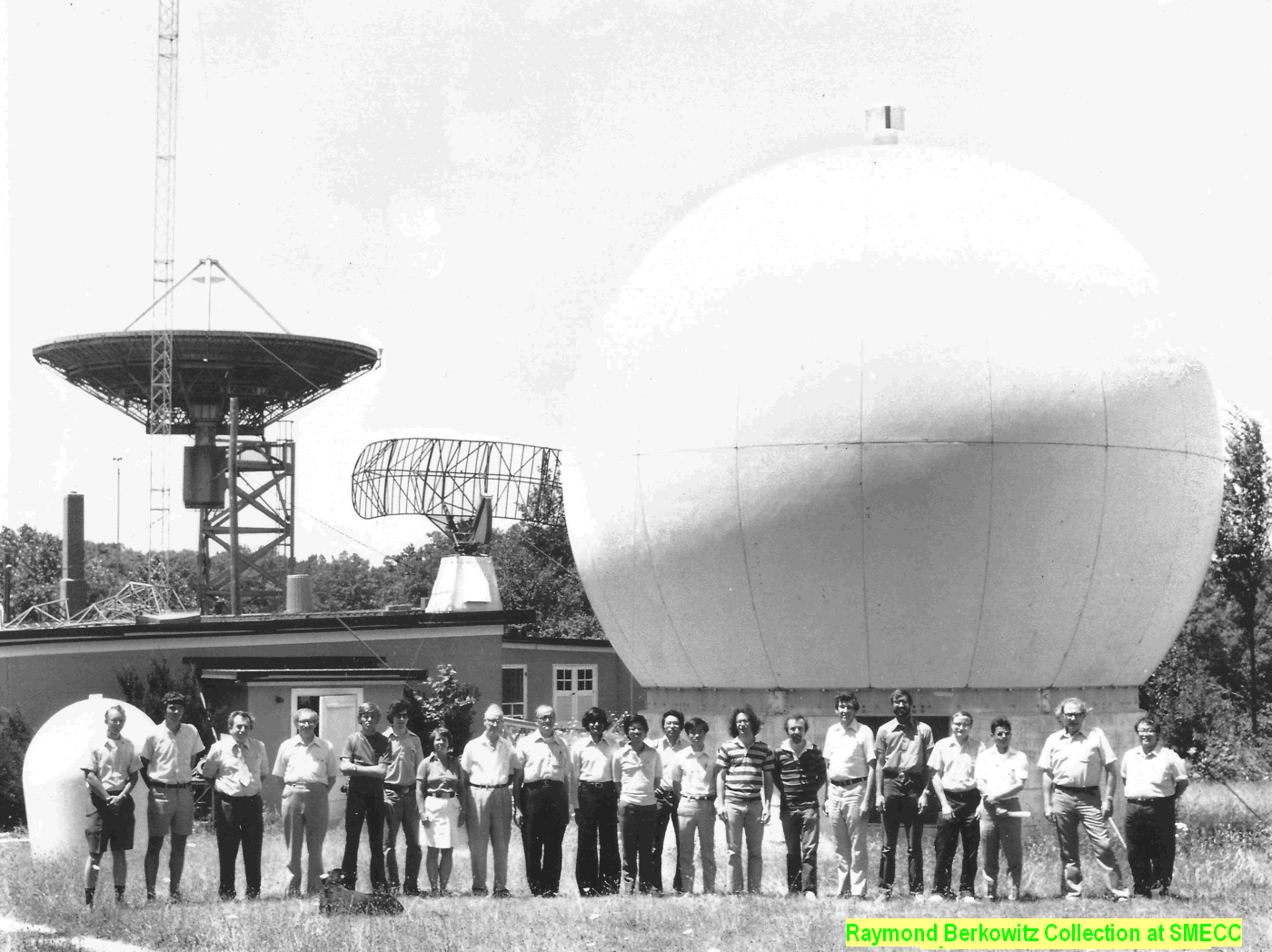 |
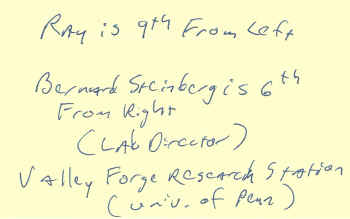 |
Inventory of the Raymond Berkowitz collection
at SMECC
Publications
Resume, Award
Lectures and Class notes
More Lectures/Notes
Multiple Target Mono Plus Radar Papers
Aegis/MFAR Consutling Papers
Research Papers
More Papers and Consulting Documents
9 bound reports
Much of his research was conducted during his consulting
work at Radio Corporation of American (RCA) and at Univ. of Penn. Valley
Forge Research Center.
There is a good picture of the Valley Forge Antennae and Research
Staff (labeled are Raymond Berkowitz and the Lab Director, Bernard
Steinberg -- one of Ray's ex PhD students).
| Author |
Date |
Title |
|
|
|
|
|
|
|
|
| DISSERTATIONS |
|
|
|
|
|
|
|
|
|
|
| David
Joseph |
1958 |
Blocking
Probabilities and Trunking Requirements in Multi-Exchange Telephone
Communications Systems |
|
| Samuel
D. Bedrosian |
1961 |
Element
Value Solution of Single-Element Kind Networks |
|
|
|
|
| Leslie
G. Callahan, Jr |
1961 |
Optimum
Linear Filtering for Line Scan Imaging Systems |
|
|
|
|
| Leslie
E. Matson, Jr. |
1961 |
Basic
Theory of Surveillance System Decision Processors |
|
|
|
|
| Sidney
Shucker |
1961 |
Application
of Integral Equations to Approximate Solutions of Electrical
Engineering Problems |
|
|
| Walter
Weinstock |
1964 |
Target
Cross Section Models for Radar Systems Analysis |
|
|
|
|
| Matthew
J. Campanella |
1965 |
Investigation
into the Fluctuation of Laser Signals Caused by Simultaneous
Multimode Oscillations |
|
| Harold
Moris Finn |
1965 |
Efficient
Multiple Stage Decision Processing for Radar Surveillance |
|
|
|
| Samuel
M. Sherman |
1965 |
Complex
Indicated Angles in Monopulse Radar |
|
|
|
|
|
| Josh
Thomas Nessmith, Jr |
1965 |
Modulation
of Wide-Band Radar Signals by Diffraction Effects |
|
|
|
|
| Peyton
Zimmerman Peebles, Jr. |
1967 |
Processing
Methods and Basic Limitations of Multiple Target Monopulse Radar |
|
|
|
| Robert
Arnold Ternus |
1969 |
Detection
of Stationary Targets in the Ground Clutter Environment |
|
|
|
|
| Leonard
Weinberg |
1970 |
Detection
in Clutter and Noise |
|
|
|
|
|
|
| Tomomi
Murakami |
1970 |
Radar
Clutter Attenuation |
|
|
|
|
|
|
|
| Pier
Francesco Guarguaglini |
1972 |
Digital
Sequential Procedure in a Range-Sampled System |
|
|
|
|
| Thomas
J. Duffy |
1975 |
Decoupled
State and Bias Estimation Applied to Trajectory Reconstruction |
|
|
|
| Tomislav
Angel Dzekov |
1976 |
Microwave
Holographic Imaging of Aircraft with Spaceborne Illuminating Source |
|
|
| Marvin
Ira Rozansky |
1978 |
Radar
Processing with Baseband Hard Limiting |
|
|
|
|
|
| Lawrence
R. Burgess |
1981 |
Design
Constraints on the Realization of Adaptive Nulling Arrays |
|
|
|
|
| Stanley
Man Fung Yuen |
1988 |
Time
and Order Recursive
Multichannel Adaptive Filtering Techniques |
|
|
|
| |
|
|
|
|
|
|
|
|
|
|
| MASTER"S
THESES |
|
|
|
|
|
|
|
|
|
|
| Raymond
S. Berkowitz |
1948 |
Passive
Two Terminal - Pair Networks Having Impedance Characteristics
Constant With Respect to Load Variation |
| Gerard
J. Mayer, Jr. |
1976 |
The
Application of the Chirp Z-Transform to Pulse Compression |
|
|
|
|
| Tae
Sun Kim |
1989 |
Detection
of Buried Object |
|
|
|
|
|
|
| |
|
|
|
|
|
|
|
|
|
|
| |
|
|
|
|
|
|
|
|
|
|
|
| |
|
BERKOWITZ
RAYMOND S. April 20, 2006, of Phila. Husband of Gisha (nee
Linchis); father of David (Lois Aaron) Berkowitz, Steven
(Johanna Norman) Berkowitz and Alan (Miriam Straus) Berkowitz;
brother of David Berkowitz; grandfather of Allison, Jacob,
Avery, Jesse, Isaac, Jonah and Eli. Relatives and friends are
invited to Services Sun. 2:30 P.M. JOSEPH LEVINE AND SON, N.
Broad St. above 71st Ave. Int. Roosevelt Memorial Park. The
family will return to the late residence. In lieu of flowers
contributions in his memory may be made to The Germantown Jewish
Center or The Unitarian Universalist House/Music Fund.
- See more at: http://www.legacy.com/obituaries/philly/obituary.aspx?n=raymond-s-berkowitz&pid=17524206&fhid=4370#sthash.XReiK52X.dpuf

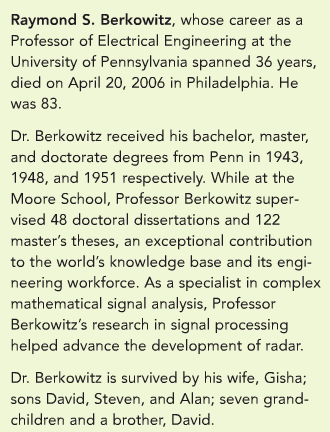
From
sept-oct 06 alumni mag.
Dr.
Raymond S. Berkowitz EE’43 GEE’48 GrE’51, Germantown, Pa.,
emeritus professor of electrical engineering at the University, who
specialized in complex mathematical signal analysis; April 20. He worked
on radar systems at RCA, 1943-44. During World War II he was a U.S. Navy
radio engineer on the destroyer USS Joseph P. Kennedy Jr., where he
served with Robert Kennedy. |
| |
| |
|
|
| |
|






